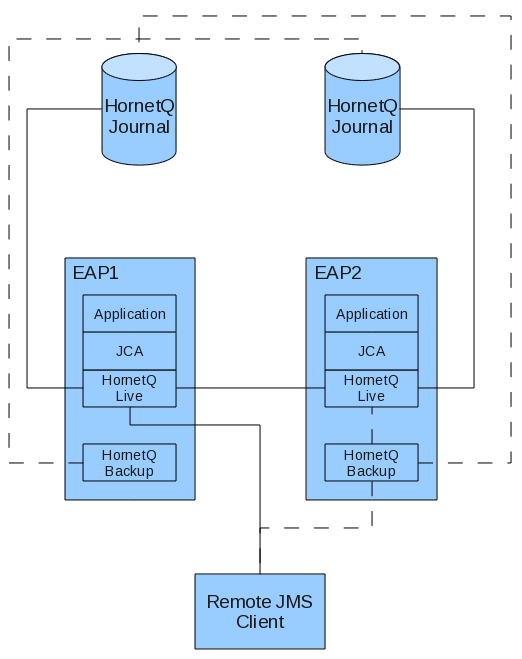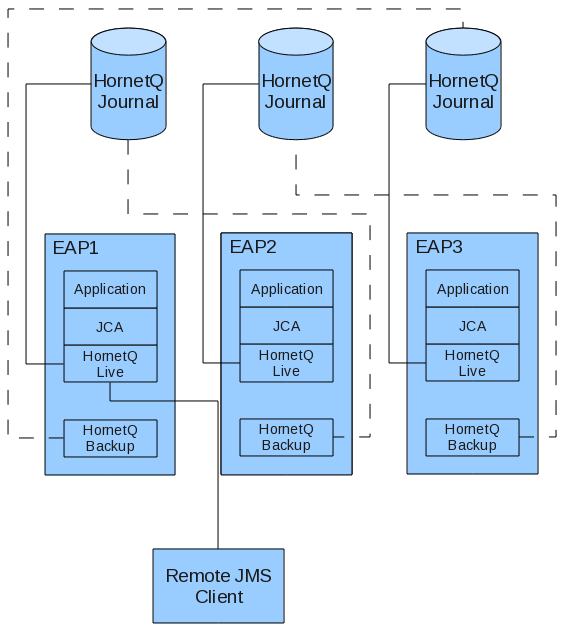이 콘텐츠는 선택한 언어로 제공되지 않습니다.
Chapter 38. Colocated and Dedicated Symmetrical Cluster Configuration
An instance of HornetQ running on JBoss Enterprise Application Platform that is configured to fail over to a specified group of HornetQ instances.
- Colocated
- Topology containing one live, and at least one back-up server running concurrently. Each backup node belongs to a live node on another JBoss Enterprise Application Platform instance.
- Dedicated
- Topology containing one live and at least one backup server. Only one server can run at any given time.
38.1. Colocated Symmetrical Live and Backup Cluster
Note
$JBOSS_HOME/extras/hornetq/resources/examples/symmetric-cluster-with-backups-colocated. The readme in this directory provides basic configuration required to run the example.
Example 38.1. Two Instance Configuration
Note
Example 38.2. Three Instance Configuration
38.1.1. Colocated Live Server
Important
Procedure 38.1. Create Live Server Profile
production profile to customize the live server configuration.
Important
- Navigate to
$JBOSS_HOME/server/ - Copy the
productionprofile, and rename it toHornetQ_Colocated
Procedure 38.2. Configure Shared Store and Journaling
- Navigate to
$JBOSS_HOME/server/HornetQ_Colocated/deploy/hornetq/ - Open
- Add the <shared-store> element as a child of the <configuration> element.
<shared-store>true</shared-store>
<shared-store>true</shared-store>Copy to Clipboard Copied! Toggle word wrap Toggle overflow - Ensure the bindings, journal, and large messages path locations are set to a location the live backup group can access.You can set absolute paths as the example describes, or use the JBoss parameters that exist in the configuration file.If you choose the parameter option, and you do not use the default paths that these parameters resolve to, you must specify the path your bindings, journal, and large messages reside in each time you start the server.
Copy to Clipboard Copied! Toggle word wrap Toggle overflow Note
Ensure you specify paths that are accessible to the live backup groups on your network.Note
Change ServerA to the name suitable to your server instance.
Procedure 38.3. Configure JMS Client Graceful Shutdown
- Navigate to
$JBOSS_HOME/server/HornetQ_Colocated/deploy/hornetq/ - Open
hornetq-configuration.xml - Specify the <fail-over-on-shutdown> element in the area near the journal directory configuration in Procedure 38.2, “Configure Shared Store and Journaling”.
<failover-on-shutdown>true</failover-on-shutdown>
<failover-on-shutdown>true</failover-on-shutdown>Copy to Clipboard Copied! Toggle word wrap Toggle overflow Note
You are not constrained where you put the element in thehornetq-configuration.xmlfile, however it is easier to find the less detailed settings if they are all located at the top of the file. - Save and close the file.
Note
forceFailover through the JMX Console or the Admin Console on the core server object.
JBOSS_DIST/jboss-as/server/<PROFILE>/deploy/hornetq/hornetq-jms.xml.
Procedure 38.4. Configure HA Connection Factories
- Navigate to
$JBOSS_HOME/server/HornetQ_Colocated/deploy/hornetq/ - Open
hornetq-jms.xml. - Add the following attributes and values as specified below.
- <ha>true</ha>
- Specifies the client must support high availability, and must always be true for fail over to occur.
- <retry-interval>1000</retry-interval>
- Specifies how long the client must wait (in milliseconds) before it can reconnect to the server.
- <retry-interval-multiplier>1.0</retry-interval-multiplier>
- Specifies the multiplier <retry-interval> used for each subsequent reconnection pauses. By setting the value to
1.0, the retry interval is the same for each client reconnection request. - <reconnect-attempts>-1</reconnect-attempts>
- Specifies how many reconnect attempts a client should make before failing. Setting
-1means unlimited reconnection attempts.
Copy to Clipboard Copied! Toggle word wrap Toggle overflow - Define new queues in both master and backup nodes by adding one of the following configuration blocks to the specified file.For
production/deploy/hornetq/hornetq-jms.xml<queue name="testQueue"> <entry name="/queue/testQueue"/> <durable>true</durable> </queue>
<queue name="testQueue"> <entry name="/queue/testQueue"/> <durable>true</durable> </queue>Copy to Clipboard Copied! Toggle word wrap Toggle overflow Forproduction/deploy/customName-hornetq-jms.xmlNote
Ensure the file is well-formed from an XML validation perspective by ensuring the XML Namespace is present and correct in the file as specified.Copy to Clipboard Copied! Toggle word wrap Toggle overflow
38.1.2. Colocated Backup Server
hornetq-jboss-beans.xml and a hornetq-configuration.xml configuration file. Any JMS components are created from the shared journal when the backup server becomes live (configured in Procedure 38.2, “Configure Shared Store and Journaling”).
Procedure 38.5. Create Backup Server
Important
- Navigate to
$JBOSS_HOME/server/HornetQ_Colocated/deploy/ - Create a new directory called
hornetq-backup1. Move into that directory. - Open a text editor and create a new file called
hornetq-jboss-beans.xmlin thehornetq-backup1directory. - Copy the following configuration into
hornetq-jboss-beans.xml.Copy to Clipboard Copied! Toggle word wrap Toggle overflow - Save and close the file.
hornetq-jboss-beans.xml file in Procedure 38.5, “Create Backup Server” contains configuration worth exploring in more detail. The BackupConfiguration bean is configured to pick up the configuration in hornetq-configuration.xml. This file is created in the next procedure: Procedure 38.6, “Create Backup Server Configuration File”.
Note
Procedure 38.6. Create Backup Server Configuration File
- Navigate to
$JBOSS_HOME/server/HornetQ_Colocated/deploy/hornetq-backup1 - Open a text editor and create a new file called
hornetq-configuration.xmlin thehornetq-backup1directory. - Copy the following configuration into
hornetq-configuration.xmlCopy to Clipboard Copied! Toggle word wrap Toggle overflow - Save and close the file.
hornetq-configuration.xml file in Procedure 38.6, “Create Backup Server Configuration File” contains specific configuration which is discussed in hornetq-configuration.xml Configuration Points.
hornetq-configuration.xml Configuration Points
- <jmx-domain>org.hornetq.backup1</jmx-domain>
- Specifies the object name (in this case the backup server) in the Java Management Extensions (JMX) service. The default value is
org.hornetq, however this name is already in use in other parts of HornetQ. You must change the name to a unique, system-wide name to avoid naming conflicts with the live server. - <clustered>true</clustered>
- Specifies whether the server should join a cluster. This configuration is the same as the live server.
- <backup>true</backup>
- Specifies whether the server starts as a backup server, and not a live server. Specifying true sets the server to start as a backup server.
- <shared-store>true</shared-store>
- Specifies whether the server should reference a shared store for journaling. This configuration is the same as the live server.
- <allow-failback>true</allow-failback>
- Specifies whether the backup server automatically stops and returns to standby mode when the live server becomes available again. If set to
false, the server must be stopped manually to trigger a return to standby mode. - <bindings-directory>, <journal-directory>, <large-messages-directory>, <paging-directory>
- The paths in these elements must all resolve to the same paths the live server references. This ensures the backup server uses the same journaling files as the live server.
- <connectors>
- Two connectors are defined that allow clients to connect to the backup server once live: one connector for the netty connector factory (to allow client and server connections across different Virtual Machines); and one connector to allow the server to accept connections within the VM.
- <acceptors>
- The NettyAcceptorFactory is chosen here for VM compatibility.
- <broadcast-groups>, <discovery-groups>, <cluster-connections>, <security-settings>, <address-settings>
- The settings in these configuration blocks are standard settings.
Task: Create Configuration for Second Server Instance
Prerequisites
- Navigate to
<JBOSS_HOME>/server/ - Copy the
HornetQ_Colocateddirectory, and rename it toHornetQ_Colocated_Second. - Rename
<JBOSS_HOME>/server/HornetQ_Colocated_Second/hornetq-backup1/to<JBOSS_HOME>/server/HornetQ_Colocated_Second/hornetq-backup-serverA/ - Open
<JBOSS_HOME>/server/HornetQ_Colocated_Second/hornetq/hornetq-configuration.xml - For all parameters with data directories specified in
hornetq-configuration.xml, change the data paths to/media/shared/data/hornetq-backup.For example change:<bindings-directory> /media/shared/data/serverA/bindings </bindings-directory>to <bindings-directory> /media/shared/data/hornetq-backup/bindings </bindings-directory> - Open
<JBOSS_HOME>/server/HornetQ_Colocated_Second/hornetq-backup-serverA/hornetq-configuration.xml - For all parameters with data directories specified in
hornetq-configuration.xml, change the data paths to/media/shared/data/serverA.For example change:<bindings-directory> /media/shared/data/hornetq-backup/bindings </bindings-directory>to <bindings-directory> /media/shared/data/serverA/bindings </bindings-directory>

